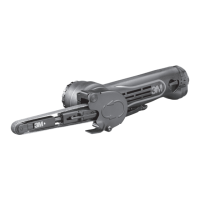6 Translation of Original Instructions
!
CAUTION
To reduce the risk associated with whipping or hazardous pressure-rupture:
• Ensure supply hose is oil resistant and is properly rated for required work pressure.
• Do not use tools with loose or damaged air hoses or fittings.
• Be aware that incorrectly installed hoses and fittings might unexpectedly come loose at any time and create a whipping/
impacthazard.
To reduce the risk associated with fly off of abrasive product or parts:
• Use care in attaching abrasive product and mounting hardware; follow the instructions to ensure that they are securely attached
to the tool before use or free-spinning.
• Never point this product in the direction of yourself or another person, or start tool unintentionally.
• Never over-tighten accessory fasteners.
NOTICE
To maximize the life of the system:
• Do not operate tool without a properly attached 3M™ abrasive.
• Reference Maintenance/Lubricating and Operating Instructions section for proper lubrication procedures.
INTENDED USE
The 3M™ File Belt Sander is intended for use in industrial locations, and used only by skilled, trained professionals in accordance with
the instructions in this manual. The 3M™ File Belt Sander is designed to effectively remove spot welds with less manual effort and
force than spot weld drills. The tool can also be used to remove gaskets and sealants. Only accessories specifically recommended by
3M should be used with this tool. Use in any other manner or with other accessories could lead to unsafe operating conditions.
• Do not operate tool in water or in an excessively wet application.
• Do not use abrasive products that have a Max RPM less than the Max RPM rating marked on the tool.
• Maintain labels and nameplates. These carry important information. If unreadable or missing, contact a 3M service facility for a
free replacement.
At the end of its useful life, recycle or dispose of tool according to federal, state, and local regulations.
PRODUCT CONFIGURATION/SPECIFICATIONS
Model
No.
Belt Size
In. (mm)
Motor
Speed
(RPM)
Belt
Speed
SFPM
(SMPM)
Product
Net Wt
lb (kg)
Height
In.
(mm)
Length
In.
(mm)
Width
In.
(mm)
Motor
hp
(W)
Noise
Level
dBA
Pressure
(Power)
Vibration
Level
m/s
2
Uncertainty
Km/s
2
33573
1/2 × 13
(13×300)
17,000
4100
(1250)
1.91
(0.87)
2.87
(73)
12.50
(320)
3.80
(96)
.65
(485)
87.0
(98.0)
1.71 0.66
33575
1/2 × 18
(13×457)
17,000
4100
(1250)
2.03
(0.92)
2.87
(73)
15.15
(385)
3.80
(96)
.65
(485)
87.5
(98.5)
1.92 0.68
* Declared noise level; measurements carried out in accordance with EN ISO 15744. It is recommended to wear ear protection while
using this tool.
** Declared vibration level in accordance with standard EN ISO 28927.
IMPORTANT NOTE: The noise and vibration values stated are from laboratory testing in conformity with stated codes and standards
and are not sufficient risk evaluation for all exposure scenarios. Values measured in a particular work place may be higher than the
declared values. Exposure to high noise levels can cause permanent, disabling hearing loss and other problems, such as tinnitus
(ringing, buzzing, whistling or humming in the ears). Therefore, risk assessment and the implementation of appropriate controls
for these hazards are essential. The actual exposure values and amount of risk or harm experienced to an individual is unique to
each situation and depends upon the surrounding environment, the way in which the individual works, the particular material being
worked, work station design, as well as upon the exposure time and the physical condition of the user. 3M cannot be held responsible
for the consequences of using declared values instead of actual exposure values for any individual risk assessment.

